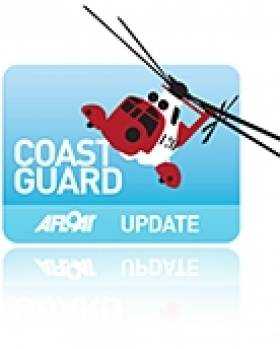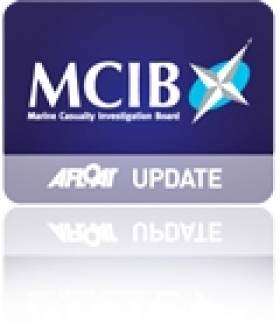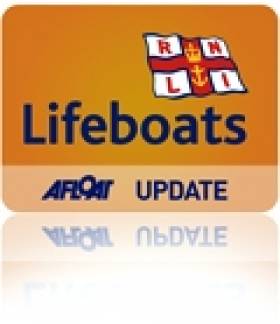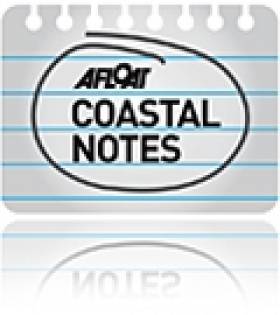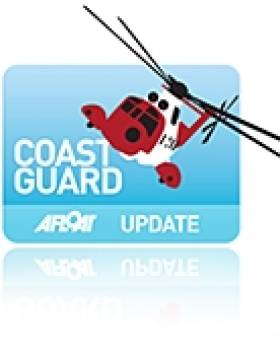Displaying items by tag: Irish Coast Guard
Valentia and Malin Head Coastguard Stations Will Not Be Closed Says Minister
#COASTGUARD - BreakingNews.ie reports that the coastguard stations at Malin Head and Valentia will remain open, following a statement to the Dáil by the Minister for Transport this evening.
Coastal communities in Donegal and Kerry had been protesting against plans to close their respective Irish Coast Guard radio stations in the wake of the 'value for money' report commissioned earlier this year by the office of Transport Minister Leo Varadkar.
Both stations were earmarked for potential closure amid concerns that the minister was allegedly looking at an "alternative technical solution" within his own constituency in Blanchardstown.
However this evening Minister Varadkar assured local communities that their coastguard centres would not be closed, while also expressing disappointment at the treatment of officials from his department at a recent joint committee meeting on the matter.
Meanwhile, the Save Our Station campaign group at Valentia has welcomed the news, telling RTÉ News that "common sense has prevailed".
Spokesperson Anthony O'Connell said that he hoped the minister's move marked the end of any threat to the future of the stations at Valentia and Malin Head.
The news comes just two weeks after an East Londonderry MLA sought the support of Northern Ireland's Minister of State to protect the Malin Head station from the chop.
Bilge Alarms Recommended for Fishing Vessels - MCIB
#MCIB - Bilge alarms in compartments below the water line have been recommended for fishing vessels in the official report into the sinking of the FV Amy Jane off Donegal last year.
As previously reported on Afloat.ie, the six-man crew of the crabber were rescued by coastguard helicopter some 13 miles off Malin Head on the morning of 7 October 2011 after the boat began taking on water overnight.
The vessel had left Greencastle Harbour in the early hours headed out to haul pots from the crab grounds off Malin Head when the crew discovered that the boat was down by the head. The pot store was found to be full of water, and attempts to pump it out made little difference.
The alarm was raised via radio with Malin Head Coast Guard before 9am and Irish Coast Guard helicopter Rescue 118 was tasked to the scene, lifting all six crew from the stricken vessel by 10.30am.
The report by the Marine Casualty Investigation Board (MCIB) found that corrosion within the Vivier tank system - used to preserve the boat's catch - was the likely source of the breach that led to the vessel taking on water.
Though an unusual thump or bump was noticed by the skipper on watch around 3am, nothing obvious was discovered, and neither the listing at the boat's head nor the flooding of the pot store - which had no bilge alarm - were noticed till after sunrise.
Aside from recommending the installation of bilge alarms for all compartments below the water line on fishing vessels, the report also called for consideration to include survey guidelines for Vivier systems, which are exposed to the same environment as the hull.
The full report on the Amy Jane incident is available to download via the link below.
Exclusive Footage of Tit Bonhomme Rescue on RTÉ
#MARITIME TV PROGRAMMES - Footage from the rescue of the only survivor of the Tit Bonhomme tragedy in West Cork last January will feature in the first of a new series of Ireland's Search and Rescue tomorrow evening on RTÉ One.
Abdul Mohammed, 43, survived the sinking of the trawler when it ran around in rough seas near Adam's Rock at Glandore Harbour, after he was able to reach the shore.
His brother Wael Mohammed (35) died along with skipper Michael Hayes (52), Saied Ali Edlin (26), Attea Shaban (26) and Kevin Kershaw (21) when the boat went down.
As the Southern Star reports, Mohammed will feature in Sunday's programme talking to presenter Claire Byrne about his struggle to survive the tragedy, while exclusive footage from the Irish Coast Guard's Rescue 117 helicopter, the Irish naval vessel LE Niamh and Naval Service divers shows the search for the missing fisherman in the wake of the incident - a first for Irish television.
The first episode of the six-part series will be broadcast this Sunday 18 November at 6.30pm on RTÉ One.
MLA Seeks NI Minister's Support for Malin Head Coastguard
#COASTGUARD - An MLA for East Londonderry has sought the support of Northern Ireland's Minister of State to protect the Irish Coast Guard station at Malin Head from closure.
Inishowen News reports that the SDLP's John Dallat MLA contacted Mike Penning regarding the threat looming over the Donegal coastguard station, which is the most northerly on the island of Ireland.
Dallat said: “When Mike Penning was Minister for Transport in Westminster he was instrumental in keeping the coastguard station at Bangor, Co Down, open, and he made his judgement on the basis that Bangor had a special working relationship with Malin Head which was critical to ensuring there was a complete coverage of all areas."
“It would be ironic now if Malin Head, which saved Bangor, was itself to be victim of closure. That must not happen and I believe Mr Penning’s support is an important element in this campaign which must not fail."
As reported recently on Afloat.ie, coastal communities in both Donegal and Kerry have been protesting plans to close the stations at Malin Head and Valentia in the wake of a 'value for money' report commissioned by the Republic's Minister for Transport Leo Varadkar.
Coastguard chiefs have criticised the studies conducted by consultants Fisher Associates into the IRCG and the Marine Survey Office.
Inishowen News has more on the story HERE.
Dunmore East Volunteer is RNLI Photographer of the Year
#RNLI - Neville Murphy of Dunmore East lifeboat station has been named the RNLI's Photographer of the Year for 2012.
The public came out in force on Facebook to vote for 'The Calm', his shot of heavy weather jackets hanging in the locker room at the Waterford station as the best out of 12 stunning images selected for the shortlist.
Murphy, a native of Skibbereen in Co Cork, has been on the all-weather lifeboat crew fat Dunmore East for 10 years since his job as a winch man with the Irish Coast Guard brought him to Waterford.
See a gallery with the winning photo and the runners up HERE.
Surfers To Clash With Council Over Doolin Development
#DOOLIN PIER - The Irish Times reports that surfers will be at loggerheads with Clare County Council this week over controversial plans to redevelop Doolin Pier.
The €8 million plans for the Clare coastal village have been delayed for some time, and have already cost the council more than €250,000.
As previously reported on Afloat.ie, the development was backed unanimously by Clare councillors in March 2011 after revisions made following concerns from local surfers about its impact on popular waves in the area.
However, the Irish Surfing Association (ISA) maintained that even that revised plan would result in the elimination of the waves at Doolin Point and Crab Island - the latter described as Ireland's answer to the Pipeline in Hawaii.
The proposed new pier would serve the 70,000 passengers that use the ferry service between Doolin and the Aran Islands. The development is also supported by the Doolin unit of the Irish Coast Guard, which hopes to get a new coastguard station as part of development plans for the area.
#COASTGUARD - The Irish Examiner reports today that the Irish Coast Guard has severely criticised the first draft of the 'value for money' report on the coastguard service commissioned by Transport Minister Leo Varadkar.
Senior IRCG management berated the work of the consultants Fisher Associates who were commissioned to undertake the studies into the coastguard and Marine Survey Office.
In their observation of the report's first draft, they cite "uninformed or poor analysis; lack of dialogue on matters surfaced; lack of understanding of where the IRCG has competency or control on particular matters and where they are departmental competencies; laziness in fact finding; ignorance of how coast guards function and failure to recognise command and control issues."
They also slated "sloppiness" in the report's incorrect spelling of the service as the 'Irish Coastguard', arguing that it "reflects very, very poorly on Fisher's ability or competence in these areas".
The news comes ahead of Irish Coast Guard director Chris Reynolds' appearance before the Oireachtas Transport Committee tomorrow (Wednesday 24 October) to discuss the future of the national network of coastguard stations.
Fianna Fáil Senator Mark Daly, who worked to bring Reynolds before the committee, claims that the coastguard head's agenda is to close the stations at Valentia and Malin Head while retaining the Dublin station and a sub-base in the Transport Minister's constituency.
Elsewhere in the Irish Examiner, Dan Buckley comments on the local campaigns to save the "vital" bases at Valentia and Malin Head.
As previously reported on Afloat.ie, coastal communities in Kerry have joined with their counterparts in Donegal to protest mooted plans to close their coastguard radio stations, despite the wealth of local expertise and hundreds of thousands of euro worth of recent investment.
Coastguard Urges Proper Use of Emergency Locators After Midweek Incident
#COASTGUARD - The Irish Coast Guard has urged any sailors or aviators using emergency locator transmitters (ELTs) to take care with their use and storage after an incident last week, The Irish Times reports.
A major search and rescue operation was mounted after a signal from an aircraft emergency beacon was detected by the Valentia coastguard station and Shannon air traffic control on Wednesday night.
Two rescue helicopters and numerous ground crews were involved in the search for what was thought to be a crashed small aircraft before the beacon was found at the rear of a property on Thursday afternoon.
A spokesperson for the Irish Coast Guard said: “We would ask anyone who who has one of these devices to ensure it is properly stored and not allowed to decay.
"If the battery in one of these units dies or the device is allowed to short-circuit because of dampness, the ELT will activate."
Howth Coast Guard Operates New Side Scan Sonar
#COASTGUARD - Howth Coast Guard will be one of the first search and rescue teams to avail of the Irish Coast Guard's new side scan sonar, it has emerged.
The specialised underwater sonar is available for 24/7 response on rivers, lakes, harbours and at sea.
The device is towed under the water and feeds a live scan of the area below it to a laptop operator on the surface.
The system can detect objects of all sizes and can be used to assist with the search of a missing person, for example, to quickly identify or rule out possible search areas before sending in Garda dive teams.
Howth Coast Guard says its menders have been trained up in the operations of the sonar over the last few months, and will be available to respond by request through the National Maritime Operations Centre (NMOC).
Busy Week For Howth Coast Guard With Two Separate Cliff Rescues
#COASTGUARD - Last week saw two rapid responses by volunteers with the Howth Coast Guard in separate incidents on the peninsula.
On Saturday 22 September a walker on the Howth Head cliff path who suffered an ankle injury was evacuated for treatment.
The walker was with a friend on the path near Red Rock when the accident occurred, rendering her unable to walk. The friend called emergency services who dispatched the on-duty crew at the local coastguard station.
The team arrived quickly on scene and prepared the casualty for evacuation across farmland to the nearest location accessible by road, where they were met by paramedics.
Howth Coast Guard said that as the coastguard service's 999 centre was contacted quickly, a speedy evacuation was carried out before temperatures dropped significantly.
Later in the week, on Thursday 27 September, the Howth Coast Guard joined the Howth RNLI lifeboat and the Irish Coast Guard's Rescue 116 helicopter in responding to a Garda request for assistance with a faller on the cliffs of Howth.
The casualty was reportedly airlifted to Tallaght Hospital by helicopter. There is no word yet as to the faller's condition.


























